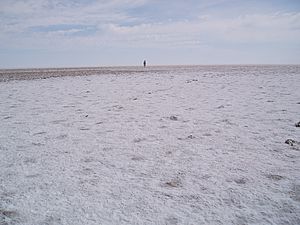Lake Eyre facts for kids
Quick facts for kids Lake Eyre |
|
|---|---|

Composite Landsat 7 satellite image using shortwave infrared, near-infrared, and blue wavelengths
|
|
| Location | northern South Australia |
| Coordinates | 28°22′S 137°22′E / 28.367°S 137.367°E |
| Type | Endorheic |
| Primary outflows | Evaporation |
| Basin countries | Australia |
| Surface area | 9500 km² (max) |
| Average depth | 1.5 m (every 3 years), 4 m (every decade) |
| Surface elevation | -15m |
Lake Eyre (pronounced "air") is a very special place in Australia. It is the lowest point in the country, sitting about 15 meters (49 feet) below sea level. When it fills with water, it becomes Australia's largest lake! It can stretch for 144 kilometers (89 miles) long and 77 kilometers (48 miles) wide.
This huge lake is found in the driest part of Australia, in northern South Australia. It only gets about 100 millimeters (4 inches) of rain each year. Lake Eyre is about 700 kilometers (430 miles) north of Adelaide. It was named after Edward John Eyre, an explorer who first saw it in 1840. Today, it is the heart of the Lake Eyre National Park.
Contents
About Lake Eyre's Geography
Lake Eyre is located in the dry desert center of Australia. It is an endorheic lake system. This means that water flows into the lake, but it doesn't flow out to the ocean. Instead, the water slowly evaporates away. This process leaves behind a large, dry salt lake.
Even when it looks dry, there are often small pools of water on the lake's surface. The water evaporates very quickly here, about 2.5 meters (8.2 feet) per year. This is much more than the amount of rain the area gets!
How Lake Eyre Fills Up
During the wet season, rivers from Queensland flow towards Lake Eyre. These rivers travel through an area called the Channel Country. This river system drains about one-sixth of Australia, which is an area as big as Spain!
How much water reaches the lake depends on how much rain falls in Queensland. The lake fills up completely only about four times every 100 years. It fills to about 1.5 meters (4.9 feet) every three years. It reaches about 4 meters (13 feet) deep every ten years.
Some big floods that filled the lake happened in 1950, 1955, and 1974-1976. In 1974, Lake Eyre was 6 meters (20 feet) deep! More recently, in February 2009, floodwaters from Queensland slowly moved towards the lake, covering about 40 kilometers (25 miles) per day.
How Lake Eyre Dries Up
When Lake Eyre is full, its water is almost fresh. This means that native freshwater fish can live in it. However, as the water evaporates, the lake becomes saltier. This happens because a thick salt crust, about 450 millimeters (18 inches) deep, starts to dissolve into the water.
This increase in salt can kill millions of fish. When the lake is about 4 meters (13 feet) deep, it becomes as salty as the sea. As it gets even shallower, it becomes much saltier. When the water is only about 500 millimeters (20 inches) deep, the lake turns a "pink" color. This color comes from a special orange pigment called beta-carotene. This pigment is made by tiny algae called Dunaliella salina.
Early History of Lake Eyre
The local Aboriginal people, the Arabunna, have ancient stories about how Lake Eyre was created. These stories are very important to their culture and are part of their sacred traditions. They are usually told only to people who have gone through special ceremonies.
Amazing Animals and Birds
When Lake Eyre has water, it becomes a home for many different animals. Freshwater fish like boney bream, golden perch, and various small hardyhead species can be found there. The Lake Eyre hardyhead is especially tough. It can live in water that is 15 times saltier than the ocean!
When the lake fills, more than 8 million birds from over 60 different species come to visit. Pelicans are often the first to arrive. They are followed by silver gulls, grebes, cormorants, ducks, banded stilts, and even birds of prey like kites, falcons, and wedge-tailed eagles. Scientists are still trying to figure out how these birds know when the lake has water.
There is also a unique lizard called the Lake Eyre Dragon (Ctenophorus maculosus). This lizard lives in the cool mud found beneath the lake's salt crust.
The Lake Eyre Yacht Club
Believe it or not, there's a group called the Lake Eyre Yacht Club! These are people who love to sail on the lake when it floods. They have had sailing trips in recent years, including 1997, 2000, 2001, 2004, 2007, and 2009. In the 1970s and 1980s, when the lake was 3–6 meters (10–20 feet) deep, many 6-meter (20-foot) trailer sailboats were used.
Land Speed Record Attempts
The salt crust on Lake Eyre is not always strong. It can be thin and break easily, like glass. However, at a place called Level Post Bay, the crust is over one meter (3.3 feet) thick. Because this area is so flat, it has been used for land speed record attempts.
In 1964, a British driver named Sir Donald Campbell set a new world record there. He drove his car, the Bluebird-Proteus CN7, at an amazing speed of 664 kilometers per hour (413 miles per hour)!
Related pages
Images for kids
-
Lake Eyre in 1990, as seen from the Space Shuttle Columbia
See also
 In Spanish: Lago Eyre para niños
In Spanish: Lago Eyre para niños






